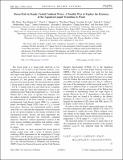| dc.contributor.author | Wang, Zhe | |
| dc.contributor.author | Liu, Kao-Hsiang | |
| dc.contributor.author | Le, Peisi | |
| dc.contributor.author | Li, Mingda | |
| dc.contributor.author | Chiang, Wei-Shan | |
| dc.contributor.author | Leão, Juscelino B. | |
| dc.contributor.author | Copley, John R. D. | |
| dc.contributor.author | Tyagi, Madhusudan | |
| dc.contributor.author | Podlesnyak, Andrey | |
| dc.contributor.author | Kolesnikov, Alexander I. | |
| dc.contributor.author | Mou, Chung-Yuan | |
| dc.contributor.author | Chen, Sow-Hsin | |
| dc.date.accessioned | 2014-08-11T13:21:23Z | |
| dc.date.available | 2014-08-11T13:21:23Z | |
| dc.date.issued | 2014-06 | |
| dc.date.submitted | 2013-12 | |
| dc.identifier.issn | 0031-9007 | |
| dc.identifier.issn | 1079-7114 | |
| dc.identifier.uri | http://hdl.handle.net/1721.1/88649 | |
| dc.description.abstract | The boson peak in deeply cooled water confined in nanopores is studied with inelastic neutron scattering. We show that in the (P, T) plane, the locus of the emergence of the boson peak is nearly parallel to the Widom line below ∼1600 bar. Above 1600 bar, the situation is different and from this difference the end pressure of the Widom line is estimated. The frequency and width of the boson peak correlate with the density of water, which suggests a method to distinguish the hypothetical “low-density liquid” and “high-density liquid” phases in deeply cooled water. | en_US |
| dc.description.sponsorship | United States. Dept. of Energy (Grant DE-FG02-90ER45429) | en_US |
| dc.publisher | American Physical Society | en_US |
| dc.relation.isversionof | http://dx.doi.org/10.1103/PhysRevLett.112.237802 | en_US |
| dc.rights | Article is made available in accordance with the publisher's policy and may be subject to US copyright law. Please refer to the publisher's site for terms of use. | en_US |
| dc.source | American Physical Society | en_US |
| dc.title | Boson Peak in Deeply Cooled Confined Water: A Possible Way to Explore the Existence of the Liquid-to-Liquid Transition in Water | en_US |
| dc.type | Article | en_US |
| dc.identifier.citation | Wang, Zhe, et al. "Boson Peak in Deeply Cooled Confined Water: A Possible Way to Explore the Existence of the Liquid-to-Liquid Transition in Water." Phys. Rev. Lett. 112 (June 2014), 237802. © 2014 American Physical Society | en_US |
| dc.contributor.department | Massachusetts Institute of Technology. Department of Nuclear Science and Engineering | en_US |
| dc.contributor.mitauthor | Wang, Zhe | en_US |
| dc.contributor.mitauthor | Liu, Kao-Hsiang | en_US |
| dc.contributor.mitauthor | Le, Peisi | en_US |
| dc.contributor.mitauthor | Li, Mingda | en_US |
| dc.contributor.mitauthor | Chiang, Wei-Shan | en_US |
| dc.contributor.mitauthor | Chen, Sow-Hsin | en_US |
| dc.relation.journal | Physical Review Letters | en_US |
| dc.eprint.version | Final published version | en_US |
| dc.type.uri | http://purl.org/eprint/type/JournalArticle | en_US |
| eprint.status | http://purl.org/eprint/status/PeerReviewed | en_US |
| dc.date.updated | 2014-07-23T20:47:48Z | |
| dc.language.rfc3066 | en | |
| dc.rights.holder | American Physical Society | |
| dspace.orderedauthors | Wang, Zhe; Liu, Kao-Hsiang; Le, Peisi; Li, Mingda; Chiang, Wei-Shan; Leão, Juscelino B.; Copley, John R. D.; Tyagi, Madhusudan; Podlesnyak, Andrey; Kolesnikov, Alexander I.; Mou, Chung-Yuan; Chen, Sow-Hsin | en_US |
| dc.identifier.orcid | https://orcid.org/0000-0002-4909-2773 | |
| dc.identifier.orcid | https://orcid.org/0000-0003-3597-1168 | |
| dc.identifier.orcid | https://orcid.org/0000-0001-6588-2428 | |
| mit.license | PUBLISHER_POLICY | en_US |
| mit.metadata.status | Complete | |
